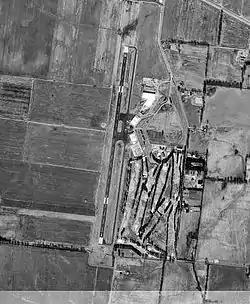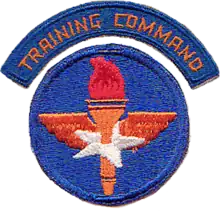Everett–Stewart Regional Airport
Everett–Stewart Regional Airport (IATA: UCY, ICAO: KUCY, FAA LID: UCY) is in Obion County, Tennessee, five miles southeast of Union City, Tennessee.[1] The National Plan of Integrated Airport Systems for 2011–2015 categorized it as a general aviation facility.[2]
Everett–Stewart Regional Airport | |||||||||||
|---|---|---|---|---|---|---|---|---|---|---|---|
 USGS 1997 orthophoto | |||||||||||
| Summary | |||||||||||
| Airport type | Public | ||||||||||
| Owner | Obion County | ||||||||||
| Serves | Union City, Tennessee / Martin, Tennessee | ||||||||||
| Elevation AMSL | 336 ft / 102 m | ||||||||||
| Coordinates | 36°22′47″N 088°59′09″W | ||||||||||
| Website | http://box5754.temp.domains/~estewart/ | ||||||||||
| Map | |||||||||||
 UCY | |||||||||||
| Runways | |||||||||||
| |||||||||||
| Statistics (2009) | |||||||||||
| |||||||||||
The airport is named for Senator Tom Stewart and Congressman Robert A. "Fats" Everett.[3]
Facilities
The airport covers 857 acres (347 ha) at an elevation of 336 feet (102 m). Its single runway, 1/19, is 6,503 by 100 feet (1,981 x 30 m).[1]
For its services, the airport offers Self-serve & Full-service fueling, aircraft tie-downs, public & private hangar space, 3 crew cars, and an A&P mechanic shop based on the northern end of the field, along with bathroom facilities, vending machines, ice bags, multiple grades of piston aircraft oil, and a pilot's lounge. The airport also owns 3 tugs for the towing of aircraft, a 12/28-volt Start-Cart, and a larger 28/120/208-volt DC/AC Diesel Ground Power Unit.
For refueling operations, the airport has 2 above-ground tanks and 1 3,000 gallon fueling truck. Each above ground tank has a capacity of 12,000 gallons; one for 100-octane low-lead Avgas & one for Jet A-1. The Jet A-1 fuel sold there is mixed with Prist, an icing inhibitor. The 3,000 gallon fuel truck carries JET A-1, and has nozzles to facilitate fueling via over-wing and by Single-point, along with variable pump speed.
For aircraft storage, the airport still retains the two main World War 2 hangars it had; it maintains them for use as public space, to either be leased or temporarily rented nightly. For private hangar space, the airport has 14 modern T-hangars, which are leased to clients.
In the year ending October 30, 2009 the airport had 20,000 aircraft operations, average 54 per day: 92% general aviation, 7% air taxi, and 2% military. 25 aircraft were then based at this airport: 76% single-engine and 24% multi-engine.[1]
For the year ending on December 31, 2017 the airport had 33 aircraft based on-field, 30 of which were single-engine piston powered, and the remaining 3 of which were twin-engine piston powered aircraft. The airport averaged 78 aircraft operations per day over the 12-month period; 53% local general aviation, 42% transient general aviation, 5% Air Taxi, and <1% Military.[4]
History
Established in 1942 by the United States Army Air Forces. Also then known as Union City Airport. When activated on July 5, 1942, the airfield had one 1,800' north-south asphalt runway, and a 4000 x 3900 sod landing/takeoff area. There also may have been 3 auxiliary landing fields in the area.
The Airfield was operated under contract to the USAAF by Embry Riddle-McKay Co. of TN & Riddle Aeronautical Institute providing flight (level 1) instruction to cadets, mainly in Fairchild PT-19s. There were also several PT-17 Stearmans and a few P-40 Warhawks. Contract training was performed there until the airfield was inactivated on April 15, 1944 with the drawdown of AAFTC's pilot training program.
At the end of the war, the airfield land was turned over to civil control through the War Assets Administration (WAA) under the prerequisite that the land must remain in use as an airport available to the public.
Southeast Airlines DC-3s stopped there 1957-59, and Southern Airlines DC-3s in 1961-63.
Since then, and in modern times, the airport traffic mainly consists of local & transient General Aviation (GA) aircraft, ranging in commonality from Cessna 150, 172 & 182 (skylane), Beechcraft Bonanza, Cirrus SR-22, along with many others. The airport also has occasional business & charter traffic; often showing up a few times a week. These aircraft range from smaller turbine & turbofan aircraft such as those from Beechcraft's King Air series, Mitsubishi's MU-2, Cessna's Citation series, and Learjet 45 aircraft. Larger aircraft commonly seen include but are not limited to Cessna Citation X+, Dassault Falcon 900 & Falcon 50, Bombardier Challenger 650, and Gulfstream G-IV.
Helicopter operations at the airport are much less common at KUCY, although they are still seen at least a few times a week, such as the smaller Robinson R44 to Eurocopter EC135 and even UH-60 Blackhawks; A Kaman K-MAX was also once spotted there.
See also
References
- FAA Airport Form 5010 for UCY PDF. Federal Aviation Administration. Effective April 5, 2012.
-
"2011–2015 NPIAS Report, Appendix A" (PDF). National Plan of Integrated Airport Systems. Federal Aviation Administration. October 4, 2010. Archived from the original (PDF, 2.03 MB) on 2012-09-27. External link in
|work=(help) - "Airport History". Everett–Stewart Regional Airport.
- "AirNav: KUCY - Everett-Stewart Regional Airport". AirNav. Retrieved 17 September 2019.
 This article incorporates public domain material from the Air Force Historical Research Agency website http://www.afhra.af.mil/.
This article incorporates public domain material from the Air Force Historical Research Agency website http://www.afhra.af.mil/.- Shaw, Frederick J. (2004), Locating Air Force Base Sites History’s Legacy, Air Force History and Museums Program, United States Air Force, Washington DC, 2004.
- Manning, Thomas A. (2005), History of Air Education and Training Command, 1942–2002. Office of History and Research, Headquarters, AETC, Randolph AFB, Texas ASIN: B000NYX3PC
External links
- Aerial image as of February 1997 from USGS The National Map
- FAA Terminal Procedures for UCY, effective December 31, 2020
- Resources for this airport:
- FAA airport information for UCY
- AirNav airport information for KUCY
- ASN accident history for UCY
- FlightAware airport information and live flight tracker
- SkyVector aeronautical chart for KUCY
